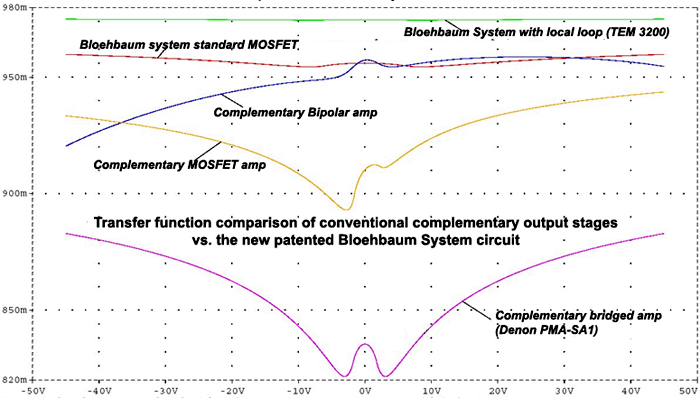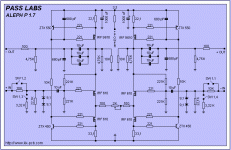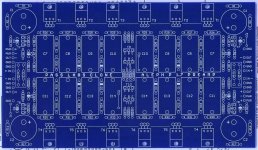In the longer term, I would be quite happy to do away with the Zen preamp stage altogether, if I could find a better way to convert from an unbalanced source to get balanced outputs for driving the circlotron. Any suggestions would be welcome!
One idea for improving the balance on the preamp output is to replace the tail resistors with active constant current sources. Another is simply to add some resistance across whichever drain resistor belongs to the side with the higher output. The first option is obviously more work, but perhaps more elegant.
Hi Chris,
It is a good news!
I think at the same time, it is worth it to investigate, why this is happened!
One of my first Pass projects was a BOSOZ preamp, I'm using it more than 15 years.
(Maybe I should just finished it already.) 🙂
And I'm not really searching for a better one.
It is a great and simple, so ZEN preamp.
Regards,
Gyuri
I have the feeling that although it may be very good when used for its intended purpose as a balanced line stage, it is probably not the optimal way of achieving what I want, which is essentially to create a phase splitter for driving the circlotron from an unbalanced audio source.
I'll maybe try running an LTSpice simulation of the Zen preamp later, to see how it should be behaving when fed from an unbalanced source (i.e. one of the Zen inputs grounded).
In the meantime, I put in the adjusting potentiometer and indeed I can now tune out the bulk of the distortion. Its down by at least a factor of 10 over the whole power range.
Chris
This is getting to the heart of the matter, I think!...Anyway, the underlying cause of the problem seems now to be identified. Many thanks to all who helped!
Super! 🙂
Joe's suggestions are spot on. A transformer is also an option.
I will try to make some measurements with my BOSOZ.
It is true, I'm usually uses it with fully balanced inputs. (You know, because of ☯️.)
I just need to reinstall my measurement computer, because my temporary license for SpectraPlus has expired.
It is true, I'm usually uses it with fully balanced inputs. (You know, because of ☯️.)
I just need to reinstall my measurement computer, because my temporary license for SpectraPlus has expired.
Super! 🙂
Joe's suggestions are spot on. A transformer is also an option.
Forgot to mention, just plain-old better matching of the devices and resistors will help too.
Yes, I'm thinking that I shall work on first getting things nicely balanced in the circlotron stages by themselves, and then afterwards, work on getting the unbalanced-to-balanced stage working nicely (i.e. producing a properly balanced output to drive the circlotron stages).Forgot to mention, just plain-old better matching of the devices and resistors will help too.
For now, I've just put a potentiometer in the over-producing side of the Zen line stage, which I then tune for minimal distortion. It's down by at least a factor of ten.
Effectively at the moment I must be partially cancelling off the small imbalance in the circlotron stages by either over-compensating or under-compensating the correction of the imbalance from the Zen line stage. This is not ideal, I think; it should be better if I separately get the circlotron balanced and then the Zen output balanced.
And by the way, I'm listening to it now, and it does sound very good. I think the distortion it was previously generating was in fact quite audible in the louder passages, and now it sounds much cleaner. I'm not very good at hearing the subtle differences that some people claim to be able to hear, but to my ears it now seems on a par with my vacuum tube OTL amplifiers that I normally listen to. And very similar in measured performance figures, in fact.
Chris
I'm not very good at hearing the subtle differences that some people claim to be able to hear,
Just as me, Chris.
Maybe it is because we are honest 🙂
One idea for improving the balance on the preamp output is to replace the tail resistors with active constant current sources. Another is simply to add some resistance across whichever drain resistor belongs to the side with the higher output. The first option is obviously more work, but perhaps more elegant.
After playing around with an LTSpice simulation of the Zen balanced line stage, I realised what I should have seen from the outset, namely that in its present form it cannot be expected to take a single input (the other input grounded) and produce a balanced output.
This is clear if one thinks of two extreme possibilities for the choice of the total resistance R between the two mosfet source pins. If one takes R=0 then the single input will indeed produce a fully balanced output. If, on the other hand, one takes R=infinity, the single input will produce a totally unbalanced output, with a signal produced at the drain of the mosfet that is receiving the single input, and zero signal produced at the drain of the mosfet whose gate is grounded. Intermediate choices for R will interpolate somewhere (calculable) between the two extreme cases.
I guess for now I shall re-jig the Zen line stage so that it does theoretically produce a true balanced output from a single input (i.e. by tying the two mosfet source terminals together). I then need to find another way to reduce the gain, without upsetting the unbalanced-to-true-balanced feature. I can then make any required fine balancing adjustments with a potentiometer.
I think this is probably better than taking the present starting point, which inherently produces an unbalanced output, and trying to make it into a balanced output by adjusting the drain resistors. To achieve that would introduce a deliberate asymmetry into the circuit to compensate for the inherent imbalance that the present circuit introduces.
Chris
One idea for improving the balance on the preamp output is to replace the tail resistors with active constant current sources. Another is simply to add some resistance across whichever drain resistor belongs to the side with the higher output. The first option is obviously more work, but perhaps more elegant.
Further to my previous post (which for some reason I cannot now edit), your suggestion of replacing the tail resistors with constant-current sources would indeed also be a reasonable-looking option. The output would indeed now be theoretically balanced, even with an unbalanced single-input source. And that would be the case for any choice of value for the source-pin to source-pin resistor R. And furthermore, different choices for R would indeed change the gain, so R could be chosen for optimal gain.
Chris
(Sorry, with the word source being used with three distinct connotations in the above, I hope there is not any confusion! I'm using "source-pin" to mean the "source" terminal of each of the mosfets.)
A transformer is also an option.
Mike, this is a great suggestion in the context of your project as it helps keep things simple (no extra power supply needed), and also seems in keeping with the underlying "mid-century" aesthetic.
I haven't checked lately, but as I recall, the cost of the transformer Nelson Pass used in the F6 amplifier (Jensen JT-123 FLPCH) was around US$30. Not bad when you consider the all-in cost of an equivalent active solution.
Last edited:
Mike, this is a great suggestion in the context of your project as it helps keep things simple (no extra power supply needed), and also seems in keeping with the underlying "mid-century" aesthetic.
I haven't checked lately, but as I recall, the cost of the transformer Nelson Pass used in the F6 amplifier (Jensen JT-123 FLPCH) was around US$30. Not bad when you consider the all-in cost of an equivalent active solution.
Somehow I have a bit of an aversion to transformers for audio signals, whether low level or high level. Even in my vacuum tube amplifiers, I go for OTL.
I would very much appreciate advice on an active-device unbalanced to balanced input stage. I am wondering if op amps are recommended as a way to do this? I happen to have a few TL047 quad op amps to hand. If I use two of the op amps in a package, one as an inverting amp and the other as a non-inverting amp, then in an LTSpice sim I get a very good performance. Would this be a good way to get the balanced signal to drive the circlotron?
One reason I am exploring this is that even in an LTSpice sim, I seem to be finding some significant limitations in what I can achieve with the Balanced Zen linestage. As I mentioned a few days ago, I realised that used just as-is, it does not even in principle give a balanced output from an unbalanced (single input) input. It is indeed possible to adjust the drain resistors to achieve a balanced output, but even then it doesn't seem to do too well. I think the problem is there is a not insignificant phase shift between the two outputs (shift away from 180 degrees, I mean), which I take it is caused by the capacitance and Miller capacitance in the mosfets. The phase shift, obviously, gets worse at higher frequencies.
By contrast, in the op amp LTSpice model I find a very much more precise 180 degree phase angle between the outputs, and also very low distortion.
I have no experience of using op amps for audio amplification, so I would appreciate any thoughts or comments on their suitability for what I want to do.
Thanks,
Chris
Hi Chris,
And what do you think about to build an Aleph 1.7?
Regards,
Gyuri
Hi Gyuri,
That looks interesting. I'd be interested to read an article describing the details of how it works; do you know of one? I guess at least in part the idea is that the source resistors of the Balanced Zen schematic have been replaced by constant-current sources? Since it is quite an involved modification of what I already have, I probably won't rush to make the change, unless there seems to be a compelling reason to do so.
A much simpler experiment I may try first is just to replace one of the two 750 ohm source resistors in each half of the Balanced Zen linestage by a constant-current source. (Retaining the other 750 ohm in each leg so that the voltage drop across the CCS won't be too high. Then I can use an LM317 for the job.) This actually sims quite well in LTSpice, gives a well-balanced output even from a single-ended unbalanced input, and does a much better job of maintaining precise 180 phase angle between outputs than is the case for the original Balanced Zen with drain resistors optimised for balanced output.
I'll probably try that as a simple mod first, and then I'll experiment with op amps instead, for unbalanced to balanced conversion.
Chris
Last edited:
Hi Chris,
There you can find all of the necessary information:
PASS LABS CLONE - ALEPH P 1.7 DIY Preamplifier PCB layout
I am also planning to build one of these, maybe sometime in the future. 😉
Kind regards,
Gyuri
There you can find all of the necessary information:
PASS LABS CLONE - ALEPH P 1.7 DIY Preamplifier PCB layout
I am also planning to build one of these, maybe sometime in the future. 😉
Kind regards,
Gyuri
Hi Chris,
There you can find all of the necessary information:
PASS LABS CLONE - ALEPH P 1.7 DIY Preamplifier PCB layout
I am also planning to build one of these, maybe sometime in the future. 😉
Kind regards,
Gyuri
Thanks; it is quite useful, though I'd still like to see a more technical discussion.
Meanwhile, I have implemented the modification suggested by Joe, of putting constant-current sources in the path from source-pin to -60V rail for each of the mosfets in the Balanced Zen line stage. This has improved things enormously. THD is now less than about 0.05% for power output up to 10W, and reaches about 0.15% at 20W.
These figures are also a considerable further improvement on the already greatly improved distortion figures I got when I tried to balance optimally the outputs from the Balanced Zen by using a potentiometer. This accords also with what I was finding in LTSpice, where it seemed that the original Balanced Zen never could produce a proper balanced output from an unbalanced single-ended input, even with the aid of a potentiometer to compensate for the inherent lop-sidedness of the outputs. This seems to be due to phase lags, presumably principally caused by capacitance in the mosfets. (i.e. one can never fully null out the sum signal obtained by adding the two balanced outputs. The problem gets worse at higher frequencies, as the relative phase deviation from 180 degrees gets worse.) By contrast, with constant-current sources the phase deviations seem to be much smaller.
I still think I shall experiment next with an op-amp unbalanced-to-balanced driver for the circlotron. For one thing, my impression from LTSpice simulations is that it will be possible to get a more accurately balanced output, and furthermore with lower distortion. Also, I find there is quite a lot of hiss generated by the Balanced Zen line stage. And then, last but not least, it goes a little against the grain, for me at least, to be using a low-level signal driver stage that generates so much heat.
Chris
An update. As I reported previously, the balanced Zen line stage gave much better performance as an unbalanced-to-balanced converter after I replaced the mosfet source resistors by constant-current sources, and as a result the distortion in the circlotron output stage was dramatically reduced. However, as I mentioned before, the level of hiss generated by the balanced Zen stage was really beyond acceptable levels.
I've now built an unbalanced-to-balanced converter using three of the four op-amps in a TL074 IC, and this replaces the balanced Zen line stage. It is doing a great job. The hiss is all gone, and the distortion is even less than with the CCS-modified balanced Zen. And furthermore, the heat generated by the unbalanced-to-balanced stage is now completely insignificant, which is all to the good since the class A circlotron is already a pretty powerful heater.
Chris
I've now built an unbalanced-to-balanced converter using three of the four op-amps in a TL074 IC, and this replaces the balanced Zen line stage. It is doing a great job. The hiss is all gone, and the distortion is even less than with the CCS-modified balanced Zen. And furthermore, the heat generated by the unbalanced-to-balanced stage is now completely insignificant, which is all to the good since the class A circlotron is already a pretty powerful heater.
Chris
Hello Everyone!
A newbie here, can i use 2SJ74GR instead of 2SJ74BL for the Amazing Circlotron?
MM
A newbie here, can i use 2SJ74GR instead of 2SJ74BL for the Amazing Circlotron?
MM
Gosh, I haven't looked at that one in quite awhile. If you lower the value of the source resistors on the JFETs (maybe 10 or 20R), you might squeak by. 🙂
Hello,
I reproduced this graph with a simulation

exicon poshpull :
http://circlotron.audio/data/simulation/img/wingspreadMosfet.png
http://circlotron.audio/data/simulation/asc/WingspreadMosfet.asc
exion circlotron :
http://circlotron.audio/data/simulation/img/wingspreadMosfetCirclotron.png
http://circlotron.audio/data/simulation/asc/WingspreadMosfetCirclotron.asc
can someone check my simulation?

thanks
I reproduced this graph with a simulation

exicon poshpull :
http://circlotron.audio/data/simulation/img/wingspreadMosfet.png
http://circlotron.audio/data/simulation/asc/WingspreadMosfet.asc
exion circlotron :
http://circlotron.audio/data/simulation/img/wingspreadMosfetCirclotron.png
http://circlotron.audio/data/simulation/asc/WingspreadMosfetCirclotron.asc
can someone check my simulation?

thanks
- Home
- Amplifiers
- Pass Labs
- The Amazing Fet Circlotron by Mike Rothacher

